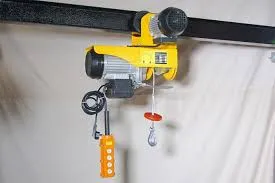


Understanding Fall Arrest Devices Protecting Workers at Height
In today's fast-paced industrial landscape, safety is paramount, especially for workers who operate at significant heights. Fall arrest devices are critical tools designed to mitigate the risks associated with working at elevated positions. These devices protect individuals from the hazards of falls, which can lead to serious injuries or fatalities. Understanding the importance, types, and proper use of fall arrest devices is essential for ensuring safety in various working environments.
The Importance of Fall Arrest Devices
Falls are a leading cause of injuries in various industries, including construction, maintenance, and telecommunications. According to the Occupational Safety and Health Administration (OSHA), falls account for a substantial percentage of worker fatalities in these fields. Fall arrest devices are engineered to prevent accidents, providing a safety net of sorts that allows workers to perform their tasks without the constant fear of falling.
These devices help reduce the severity of accidents when they do occur. By arresting a fall, the devices minimize the distance and impact of the fall, thus decreasing the likelihood of serious injuries. Moreover, using fall arrest systems can enhance worker confidence, allowing them to focus on their tasks and perform efficiently without distractions associated with safety concerns.
Types of Fall Arrest Devices
Fall arrest systems come in various forms, tailored to different applications and environments
. The most common types include1. Full Body Harnesses These are the most commonly used fall arrest devices. A full-body harness supports the entire body and distributes fall forces over a larger area, minimizing injury risk upon sudden stops.
2. Lanyards Often used in conjunction with harnesses, lanyards are connecting devices that secure workers to an anchor point. They can be static or shock-absorbing, with the latter designed to reduce the impact of a fall.

3. Self-Retracting Lifelines (SRLs) These devices automatically extend and retract as the user moves. In case of a fall, the SRL locks quickly and secures the user, greatly reducing the fall distance.
4. Anchorage Points These are critical components of a fall arrest system, providing secure points to which harnesses and lanyards can be tethered. Anchors must be capable of supporting the fall load and be strategically positioned for maximum effectiveness.
5. Guardrails and Safety Nets While not traditional fall arrest devices, these systems provide an additional layer of protection by preventing falls from occurring in the first place. Guardrails can be installed on elevated surfaces, while safety nets can catch falling workers.
Proper Use and Maintenance
Using fall arrest devices safely requires training and adherence to established guidelines. Workers must be educated on how to wear a harness correctly, how to connect lanyards to secure anchorage points, and how to perform regular inspections of their fall protection systems.
Regular maintenance is essential to ensure the effectiveness of these devices. Inspections should be conducted before each use, checking for signs of wear, damage, or malfunction. Components such as stitching, buckles, and webbing should be carefully examined. Additionally, devices should be stored properly to avoid exposure to harmful elements that could weaken the materials over time.
Employers play a crucial role in fostering a culture of safety by providing training programs, conducting regular safety audits, and ensuring compliance with regulations set forth by organizations such as OSHA. Establishing clear protocols for when and how to use fall arrest systems can significantly enhance on-site safety.
Conclusion
In conclusion, fall arrest devices are indispensable tools in the effort to protect workers at height. By preventing falls and minimizing injuries, these systems contribute significantly to workplace safety. Understanding the types of fall arrest devices, their proper use, and maintenance protocols is essential for both workers and employers. As industries continue to evolve, the adoption and proper implementation of fall protection systems will play a vital role in safeguarding health and ensuring that workers can perform their duties without fear of falling. Investing in safety is not just a regulatory requirement; it is an ethical responsibility that fosters a safer, more productive work environment for everyone involved.



